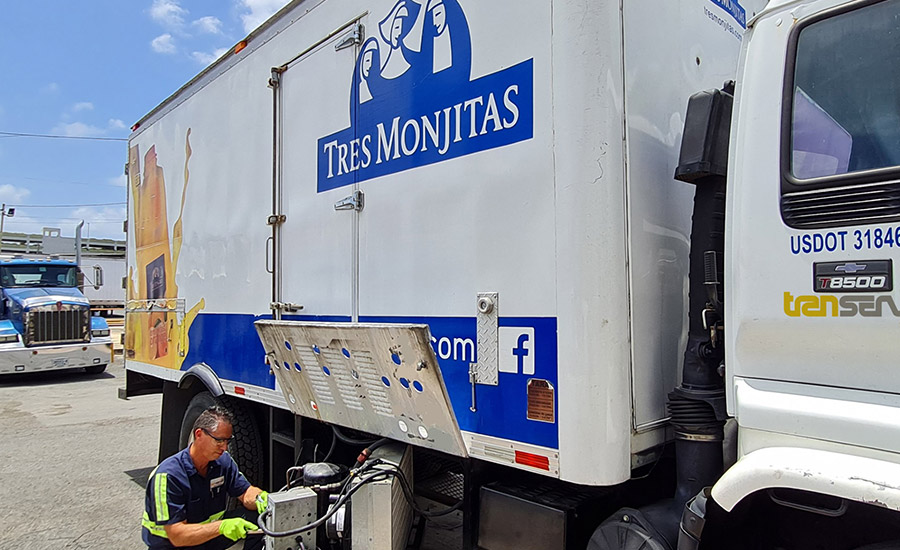The keys to dairy distribution
Processors must effectively manage a host of operational issues to cut delivery costs and maintain product quality.

Best-in-class drivers are essential for the safe delivery of products.
Photo credit: Penske Logistics
Developing and leveraging a highly effective dairy product distribution system does not come easy.
Dairy processors seeking to incorporate the most efficient networks are facing an array of obstacles, with such factors as labor and truck shortages and higher transport expenses proving to be particularly troublesome, analysts say.
The need for consistent temperature control; adherence to rigorous quality control measures; observation of strict hygiene and sanitation protocols; seamless customer service; and sustainable practices are additional variables that must be met, says Arvind Goyal, vice president of project planning and implementation for WOW Logistics, a Neenah, Wis.-based provider of logistic, transportation, warehouse, and consulting services.
“Similarly, robust traceability, trained and effective staff, and optimized transportation routes, scheduling, and inventory management will help streamline a network,” he states.
Dairy processors also must ensure that packages are aptly designed, assembled, and secured to prevent damage during transit, says Greg Parupsky, vice president of client solutions and business development at Murphy Logistics Solutions, a Minneapolis-based provider of fleets, warehouses, and distribution systems.
“Poor transportation strategy management can lead to increased costs, delivery delays, and compromised product quality,” he states. “This affects relationships up and down the supply chain. Rebuilding broken trust will require significant effort, resources, and demonstrable change.
Keep it cold
To help minimize expenses, it is critical that processors efficiently transport products while maintaining the proper refrigeration to maximize shelf life and reduce spoilage, says Jim Anderson, division vice president at Lily Transportation LLC, a Needham, Mass-based contract carrier and logistics system developer. While milk and cream cheese typically have a shelf life of one to weeks, harder cheeses and yogurts may last four to six weeks, and ice cream and frozen yogurt can subsist for two to six months, he states.
“Product integrity and timeliness of delivery are of utmost importance to ensure items are delivered at their highest quality,” says Mark Finger, vice president of operations for Transervice Logistics, a Lake Success, N.Y.-based contract carriage, fleet leasing, and freight management provider. “Optimized routing combined with equipment cleanliness and refrigeration performance are necessary to create a positive cold chain environment.”
While trucking accounts for most of the food transport in the U.S., hybrid routing techniques are becoming more prevalent, reports Infoholic Research LLP, a Hampi Nagar, India-based market research firm. “A quality food logistics provider will have solutions to meet the needs of their customers,” Infoholic Research states. “This may include using multiple forms of transportation to ensure the fastest, freshest, and safest delivery,” such as road, air, sea, and train.
Processors can better achieve consistent on-time deliveries by leveraging dedicated in-house fleets, in which they control maintenance and ensure greater output and less equipment downtime, while also leveraging third-party transports when necessary, Anderson says. “This will assist in driving down the overall cost of transportation and, more importantly, keep the cost down for the consumer.”

Systems that support the safe and efficient distribution of dairy products, meanwhile, are becoming more effective, he states. This includes the use of equipment that enable transporters to set temperature limits to ensure loads are kept within a specific range, Anderson says. Additionally, deviations from a range can trigger the sending of real-time alerts to the driver, dispatcher, and shipper, saving valuable products.
Processors also can leverage smart reefer technologies, which provide notifications on unit performance, low fuel levels, excessive cargo door open time, and other elements, Finger says, while tracking cargo area temperatures and the loaded or empty status of trailers.

“Technology is transforming dairy product transport,” Murphy Logistics Solutions’ Parupsky states. “Real-time tracking systems and faster delivery methods are more prevalent and driven by consumer expectations that have been influenced by companies like Amazon. These advancements aim to meet the demand for prompt and reliable delivery while maintaining product safety and quality.”
It is essential that processors install temperature-monitoring technology for real-time visibility if something goes wrong with refrigerated transport or a shipment is left outside, Infolic Research states. “In addition, it is crucial to know how your loads are being transported and to have shippers who are aware of how to prevent cross-contamination.”
Infoholic Research notes that a dairy product is subject “to a clock that starts ticking as soon as it leaves the processing facility” and continues until it reaches a consumer’s shopping cart.
“While following temperature control procedures is an important part of maintaining freshness, time is against you,” Infoholic Research states. “As a result, food manufacturers need to make sure they have dependable, rapid transportation to get fresh foods to their destinations quickly so that retailers, restaurants, and consumers can continue to enjoy them in their freshest form.”
Delivery can be difficult
Yet, a shortage of drivers and trucks, along with rising transportation costs, are making it challenging for processors to efficiently distribute products, Lily Transportation’s Anderson says. “Government regulations also limit the amount of time a single driver could operate each day. To support products with a shorter shelf life, longer hauls will either need team drivers or a layover prior to final delivery.”
Maintaining full truck driver employment is especially hard as best-in-class drivers are necessary for expert load securement and such individuals must be willing to work overnight and on weekends, says Justin Howes, senior vice president of operations, dedicated contract carriage, for Penske Logistics, a Reading, Pa.-based provider of supply chain management, transportation, and warehouse services.
Driver shortages can result in outbound and trip delays and inefficient production flow, Howes says. “Without the ability to forecast, plan, and communicate effectively, it is difficult to provide the highest level of customer service,” he states.
Along with having the necessary amounts of drivers and fleet to meet delivery schedules, a highly efficient transportation system will experience minimal vehicle idle times during multi-stop operations; will follow effective load securement procedures to minimize spills; and have access to the necessary yard space to better manage inventories, Howes states.
“Focus also on quality loading practices and an optimal network delivery strategy,” he says. “Partnering with best-in-class transportation experts that provide insights and actions around continuous improvement at all touchpoints will lend itself to maximum success.”
Collaborating with third-party specialists can be advantageous as processors may overlook such crucial elements as effective labor planning, facility and layout designs, and optimized workflows, which are often outside the operators’ core competency, WOW Logistics’ Goyal states. “Due to the dynamic nature of the dairy industry, inaccurate forecasting can be problematic, and ineffective cost management across transportation, storage, and distribution can reduce profitability.”
In response, processors should make robust planning and situation analysis a priority, he says.
“A comprehensive evaluation results in optimized demand forecasting, inventory accuracy, elimination of waste, ongoing continuous improvement, network resilience, and the right integration of people, processes, systems, and tools,” Goyal states. “Strategically partnering with a trusted team of supply chain experts for this assessment is one of the best investments a company can make. It enables data-driven decision-making that drives growth and profitability while keeping costs down.”

Deciding if the supply chain should have in-house or third-party service management requires operational analysis as well, says Clay Prickette, WOW Logistics’ vice president of operations. This includes determining if management is a processor’s core competency and if a physical infrastructure exists with the proper space, scope of services, and locations to drive out supply chain costs, he states.
“There also is a need to assess both internal talent and the necessary human resources bandwidth to effectively lead and support a supply chain strategy,” Prickette notes.
A high-tech solution
Processors should further ensure that they incorporate the distribution technologies that are most appropriate for their specific operations, says Mike Roeth, executive director of the Fort Wayne, Ind.-based North American Council for Freight Efficiency. He notes, for instance, that there are more than 70 technologies that heavy-duty tractor-trailers can utilize to more efficiently move products.
Operators can also lower expenses and improve efficiencies by analyzing such elements as a truck’s aerodynamics, tires and idle reduction, which can improve miles per gallon, while considering battery electric trucks and vehicles that use renewable biodiesel fuel and renewable natural gas, Roeth says.
“Sustainability is becoming a key purchasing decision for consumers and business-to-business enterprises,” he notes. “Diesel fuel costs are ever increasing and taking actions to lower consumption is a key business practice for fleets.”
More distribution systems are likely to incorporate artificial intelligence as well, says Bill Myers, WOW Logistics’ chief technology officer.
“Technology drives efficiency to get the right work done at the right time through dynamically managing resources and inventory placement,” he states. “Effective technology automates busy work and business processes to help people be faster and more accurate.”
Artificial intelligence will likely grow at a rapid pace and remold the industry with elevated levels of automation in manufacturing, logistics, warehousing, and last-mile delivery, Infoholic Research reports.
“The logistics vertical is undergoing a fundamental transformation with the increase in the amount of data and the number of devices utilized, reduction in costs to maintain competitiveness and urge to maintain the required stock levels to ensure on-time delivery,” Infoholic Research states. “All this requires some level of automation in the supply chain to allow for timely decision making.”
Anderson adds that technological advancements are improving product quality, “while ensuring that transportation meets the Food Safety Modernization Act and that, ultimately, the consumer receives a safe food supply.”
Looking for a reprint of this article?
From high-res PDFs to custom plaques, order your copy today!






